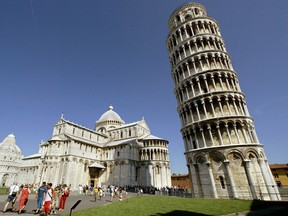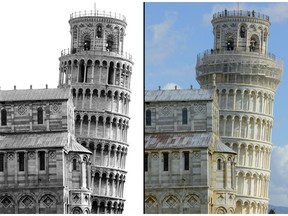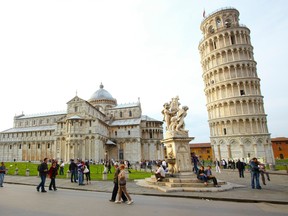
Article content
On this day in history in 2001, Italy’s Leaning Tower of Pisa reopened to the public after being closed for security reasons in 1990. A massive engineering effort, costing about $40 million, reduced the tower’s tilt and engineers say the tower’s stabilization is still successful – just over two decades since it reopened.
Advertisement 2
Article content
Here are some facts about the Leaning Tower of Pisa:
Article content
- The tower began to lean soon after it was built in 1173. It was built in three phases over a period of almost 200 years.
- Experts say the tower leaned due to soft ground that could not support the weight of the structure.
- Four earthquakes shook this part of Italy, but none brought down the tower. Scientists say the surrounding soft soil affects the vibration of earthquakes and reduces shaking.
- When the tower closed for repairs, its tilt reached the potentially dangerous level of 5.5 degrees. Repairs changed that tilt to 3.97 degrees. This meant the actual measurement of the tilt was reduced by 45 centimeters.
- A bell chamber was added in the year 1372; seven bells were installed, with each bell representing a note of a major musical scale.
- The bells were removed to take some weight off the tower as restructuring work began in 1990. Houses in the path of a possible fall were also evacuated, in case of an accidental collapse.
- To reduce the tilt of the tower, about 70 metric tons of dirt was removed from under the side of the tower that sat higher than the others.
- Experts now say the tower will be stable for around 200 years.
- The tower is hollow inside, with nearly 300 steps required to climb to the top of the 56 meter tall structure.
Advertisement 3
Article content

The following story about the tower appeared in the Calgary Herald, with restoration completed and plans made to allow the public to visit the tower again a few months later.
A new twist: A restoration project adjusted the tilt of the famous Lean Tower
Calgary Herald
Sat 21 Jul 200l
Byline: L. Brian Wingfield
Date line: PISA, Italy
Source: The Associated Press
Mark Twain once said the Lean Tower of Pisa “the strangest structure of which the world has any knowledge.” For more than a decade, experts from around the world have been working to keep it that way.
Officials have the Tower in 1990, when it leaned with a dangerous four meters from the perpendicular. In June, Italian and foreign engineers completed an 11-year, $27 million restoration project to reduce its tilt by 40 centimeters.
Advertisement 4
Article content
“It will take another 300 years for the lean to return to where it was in 1990,” predicts John Burland, an engineering professor at London’s Imperial College.
Last month, Pisans toasted the reopening of their beloved landmark with a celebration that included an operatic performance by native son Andrea Bocelli.
Gone are the support suspenders and flashy steel rings that strangle the Tower for much of the past decade. Still, visitors must wait until November to make the dizzying climb to the top as experts continue to study the structure’s stability.
In the past, tourist groups filled the eight floors Towerstep This time only 30 individuals will be allowed inside at a time.
Construction on the famous clock Tower began in 1173 Pisa was a powerful maritime republic. But it was a monument building on shifting ground. The Tower‘s south side began to sink before workers completed its third level.
Advertisement 5
Article content
The Tower was finished in 1360, still stubborn tilt – and all the more famous for it. Galileo is said to have performed his revolutionary experiments with falling objects from the intact belfry.
The landmark is part of a trio of dotted buildings Pisa‘s Campo dei Miracoli, an enormous field of lush grass. The Duomo, its massive baptistery and the Lean Tower – all majestic, creamy marble structures – witness to the city’s former glory and epitomize the Romanesque architecture of northern Italy. The Museo dell’Opera del Duomo adjacent to the complex holds an impressive collection of artworks and artifacts from the three monuments.
Just north of the Duomo lies the Camposanto, a cemetery that is believed to contain soil that was buried by Crusaders of the Holy Country. Although heavy damage by World War II bombing, the cemetery contains the remains of some of Italy’s most intriguing frescoes, including the Triumph of death, an unknown artist’s macabre depiction of Florence during the plague.
Advertisement 6
Article content
As one of Europe’s oldest university towns, Pisa has a strong intellectual tradition. The café-lined Borgo Stretto and the Piazza dei Cavalieri are often teeming with students. The prestigious Scuola Normale Superiore, founded by Napoleonic decree in 1810, occupies this piazza’s namesake palace.
At the opposite end of the piazza rests the Palazzo dell’Orologio on the site where another Tower once stood Here in 1288, the Pisan government imprisoned Count Ugolino di Gherardesca along with his sons and grandsons on suspicion of treason and starved them to death. Dante immortalized the episode in the Inferno.
Pisa‘s historic center is best seen on foot. Visitors can browse the Piazza delle Vettovaglie’s open-air market on weekday mornings. There is an ancient justify the second weekend of every month at the Ponte di Mezzo.
Pisa is on the coast of Tuscany, a region known for its food, wine and pretty hill towns. Many people visit Pisa as a day trip from Florence, about an hour away by train.


